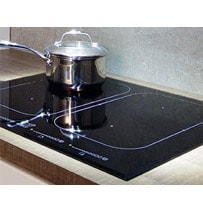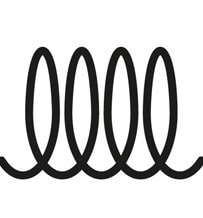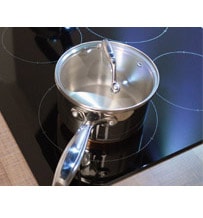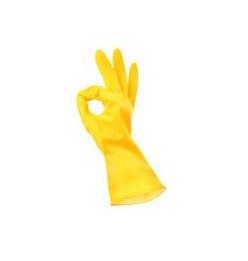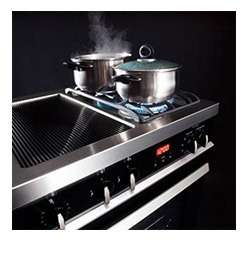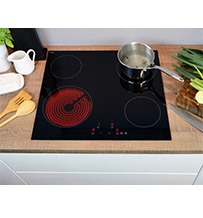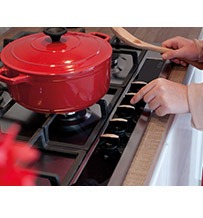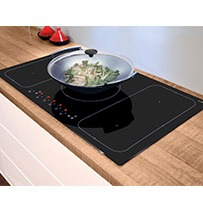CDA Buying Advice – Which Hob Should I Buy?
There are five types of hobs to choose from; electric, ceramic, gas, induction and domino. Here’s some advice to help you decide which one to buy for your kitchen.
Electric Hobs
Electric and gas are the two classic forms of hob cooking styles. Electric hobs take a minute or two to warm up, whereas gas instantly provides heat via a flame. The cooking elements on electric hobs are known as cooking rings or zones, there can be between four and six, but the more rings to cook with the higher the price. There are different sized rings for different types of pans, and each ring’s temperature is individually controlled by you. This means you could be boiling potatoes on one ring and cooking sausages on another, ideal for a busy kitchen. The majority of electric hobs will have four different looking zones that have 2 to 3 different power levels.
Many electric hobs offer different elements, such as a power boost, to be able increase the power needed to cook quickly, ideal for if you’re in a rush. One of the more important elements to an electric hob are the safety features put in place to prevent any accidents happening. A useful feature is the heat indicator that lets you know that a zone is still hot after use, warning you it should not be touched, this visually shows you and means you don’t have to burn any fingers checking if it’s still too hot or not! There are also child locks, stopping any un-wanted fingers from turning on the hob, and a handy auto switch off tool that turns off your hob if it is left unattended for a period of time, depending on the model in use.
Whilst electric hobs can offer high tech safety features like child lock, and enhanced cooking features, gas hobs still provide the best way of producing direct heat to the pans. One thing that gas hobs cannot provide though, is a sleek and polished look, like electric hobs can.
The appearance of a hob is important as you want your kitchen to look its best, therefore choosing the right finish can help bring your kitchen together. Ceramic glass can be found on ceramic and induction hobs as they use a special type of heat proof glass. It has a sleek look and is easily wiped clean. Enamel or stainless steel is found on electric plate hobs as they have sealed cooking zones.
It is good to bear in mind that the heat is difficult to control as it takes long with electric hobs to heat up, and longer to cool down in comparison to gas and induction.
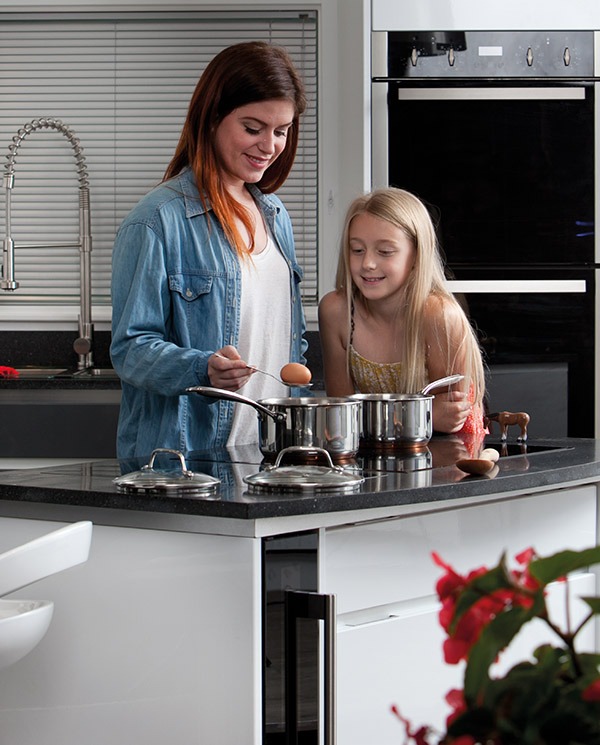
Advantages
- Power boost function, to decrease cooking times
- Child lock
- 4 or more cooking zones that can be individually controlled by you
Disadvantages
- Heat is difficult to control
- Longer to heat up and cool down
Ceramic Hobs
Ceramic hobs come with either four or five zones for cooking and look incredibly sleek and stylish due to their ‘flat’, frameless design, that will add fluidity to your kitchen as your worktop and hob join together. The flat design of a ceramic hob varies depending on whether you want the more traditional option with dials for adjusting heat, or if you opt for the more modern touch-operated design – which has no buttons or dials that stick out. It’s this design that also makes ceramic hobs extremely easy to clean and maintain.
Sat inside a special housing is an element that heats the ceramic glass, it rises through and heats whatever is sat on top of the rings. On halogen hobs, that are considered high tech, they use red lights to warm your pots and pans. But this form of heating is not as fast as gas or induction and not as efficient either, so it is up to you to decide which type of hob you would prefer to use. As mentioned above this type of design makes cleaning so much easier, gone are the days when you are scrubbing at your hob! Spillages and dirt will be easily wiped off, with no buttons or pan supports to try and work around.
They are usually more expensive than other hob types, like gas or electric, but the style and ease of ceramic hobs makes it worth it. As mentioned previously the heat is not as efficient, or distributed as evenly across the pans and can take a while to cool down. But with safety features like heat indicators that let you know which rings are hot or not, it will prevent accidents from happening.
This type of hob is low maintenance but does not compromise on style and ease. CDA has a range of styles and sizes to choose from, so the possibilities for your kitchen are endless.
Advantages
- Sleek and stylish look
- Easy to clean
- Low maintenance
Disadvantages
- Not as efficient as gas or induction
- Takes longer to cool down
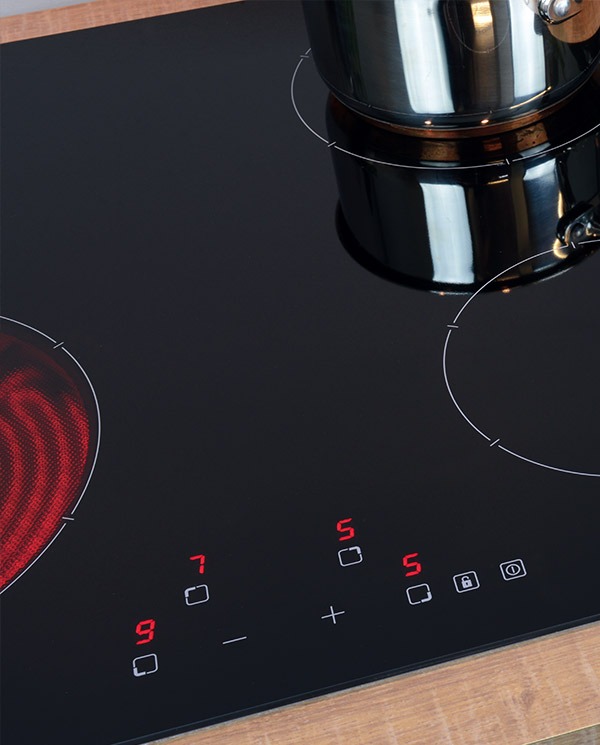
Domino Hobs
Domino hobs get their name from the classic game of dominoes; this is because they look like one of the pieces. They typically have two burners or heat zones and come in a range of different styles; you can get a domino hob in ceramic, electric, gas or induction. This type of hob can provide great flexibility when cooking, and is definitely recommended for the more active cooker. You can mix and match with the type that you want. You could have a ceramic section, then gas next to it, to suit how you cook best. Or have an induction hob as your main cooking facility, but then a separate domino hob next to that for flexible use. CDA offer a griddle domino hob, perfect for cooking steak at the same time as boiling your vegetables on your induction hob. This will be ideal if you are a passionate cook who likes to try lots of different styles, with domino hobs they can help you to vary your cooking.
Domino hobs are a great space saver if your kitchen cannot accommodate a full size hob, suitable for kitchens with limited space, and would work well in flats and kitchenette. They are not that suitable for a house that has a large cooking space, and will need to cook regularly. They are good for additional extras, but for a large family household they are perhaps too small.
Advantages
- Allows flexibility when cooking
- Suitable for kitchens with limited space
- Mix and match with your cooking styles
Disadvantages
- Perhaps not suitable for households that require more cooking space and equipment
- Expensive when compared to other models
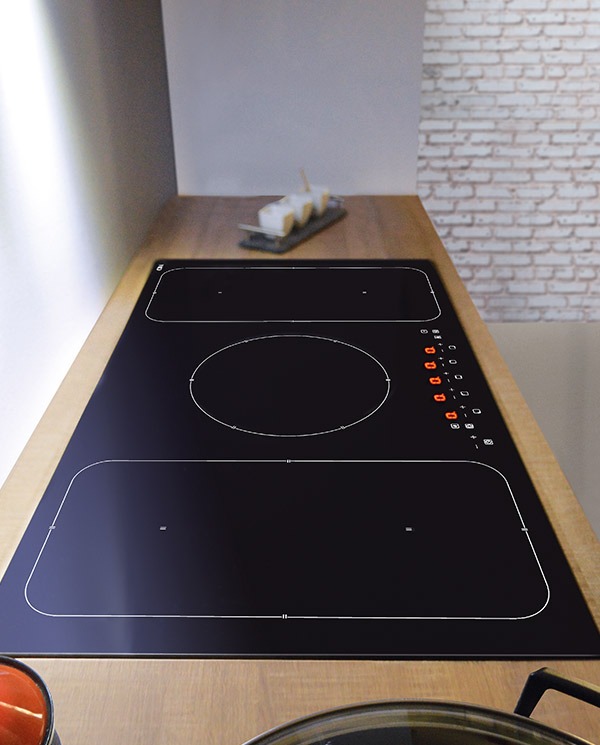
Induction Hobs
Induction hobs look similar to ceramic hobs in design and by their touch-sensitive nature, but the way in which they cook is truly unique. When you place your saucepan or frying pan on an induction hob, all of the heat is generated in the cooking vessel. This means that whilst your pan is heating up, the hob itself is not. Any spills won’t be burnt on to the hob surface. There is some residual heat in the cooking zone after it is switched off but nowhere near as much as in a ceramic or electric hob, plus it cools much more quickly too. This makes the induction hob a much safer feature in the kitchen.
The hob creates a magnetic field between the induction element and your pan, stopping heat from being wasted. It is considered a lot more efficient than ceramic or gas hobs because of the heat being directed straight to the pan and not escaping through the rest of the hob. They are quicker to heat up so you won’t need to wait around for your hob to heat, and only a small amount of residual heat is produced. They are just as stylish as other hob types available, but a lot more efficient!
Although these hobs are better for your kitchen they do have some limitations that you should be aware of before you purchase an induction hob. If you are switching from a gas hob for example to an induction, your pans may not be suitable to use on the induction. Steel or cast iron pans will be suitable for the induction hob, but copper or aluminium pans will not be, unless they have additional layers to allow a magnet to stick to it.
There are so many benefits to buying an induction hob as they are incredibly energy efficient, and stylish too, what more could you want?
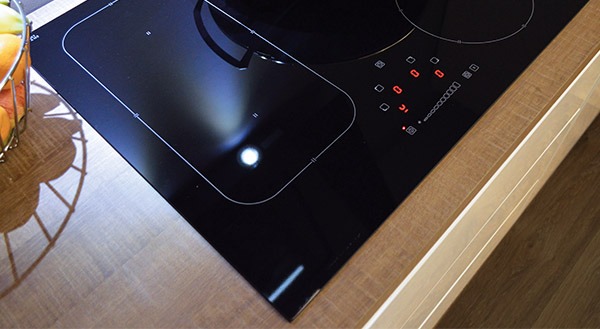
Advantages
- Heat is generated through the cooking vessel, so is more efficient
- Quick to heat up and limited residual heat is emitted
- Touch sensitive and sleek looking
Disadvantages
- Need to ensure your pans are suitable for an induction hob
- Can be expensive when compared to other hob types
Gas Hobs
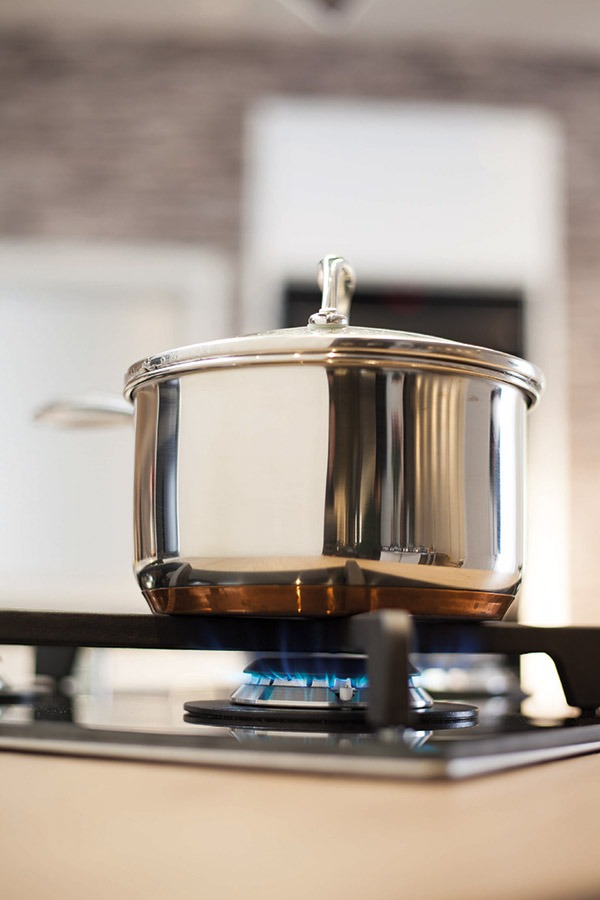
We offer a wide range of gas hobs, with a variety of different styles with 4 to 6 burners on each. They are very easy to control and are the best for providing direct heat. Most homes in the UK do not have a supply of mains gas, but manufacturers now offer a conversion kit that converts the model to be able to run on LPG gas, which is more common in households. Just ensure that the installer is gas safe registered, and that your hob can be converted to LPG.
There are various types of burners available in gas hobs, these are economy, semi rapid/rapid burners and wok burners. The different types and arrangements available depend on the model you choose. Economy are less powerful and smaller, this makes them more energy efficient and could be best used for simmering foods. Semi rapid and rapid burners give out medium and high power and would be best used boiling water. Wok burners are the biggest burners available and give out the largest amount of heat. As wok pans are wider the flames spread wider across, therefore this type of burner is only suitable for woks or large pans.
There are obvious safety concerns about using gas hobs due to the naked flame that you don’t get with ceramic or induction hobs. But there are safety features in place to stop accidents from happening. There are flame failure devices in place that stop gas travelling to the burner if the flame is put out, handy if your pan of water boils over.
There are many types of controls to choose from like rotary, touch and position. Rotary are simple controls that are pushed and turned, but are not as slick looking as touch control and can be easily knocked. This problem however could be resolved by position controls that are placed in two areas on the hob, either at the back or side, this can stop them from being knocked as easily, or children from reaching them. Another feature on a gas hob is the pan supports, these sit on the hob to hold the pan in place whilst cooking. They can be removed to ease the cleaning process, but must not be put in the dishwasher, instead they must be hand washed or wiped clean.
You can have a metal, glass or enamel finish to your hob depending on what will suit your kitchen best. There are many benefits to having a gas hob in your kitchen, the heating system is much more effective, it cools down quicker and you can choose the sizes of the burners you want.
Advantages
- Best hob type to provide direct heat
- Multiple safety features such as a flame failure device
- The choice of controls and the finish of your hob
Disadvantages
- A naked flame is present
- Cleaning process is more difficult than a ceramic hob would be


